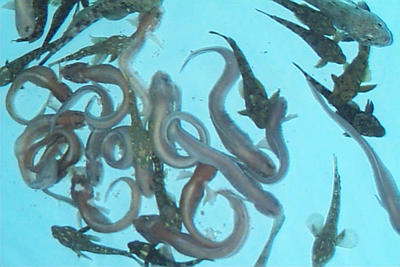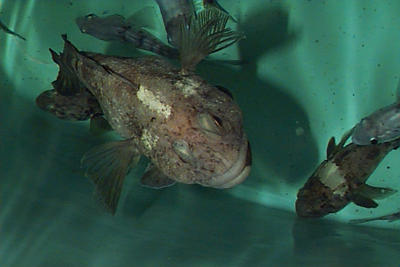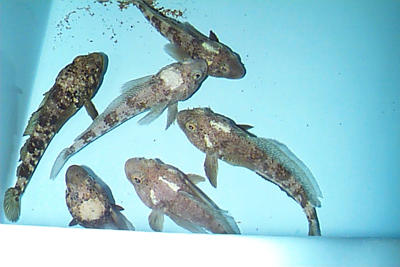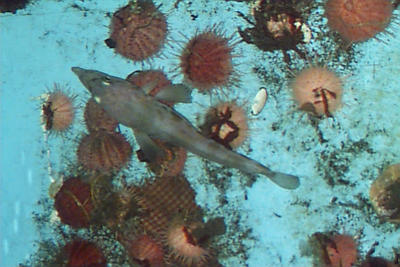2 December, 1998
FISH ADAPTATIONS
Okay, now that you've had time to think about adaptations of fish
for living in Antarctic waters at below-freezing temperatures let me
tell you some of their amazing adaptations. Most Antarctic fish belong
to the suborder of bony fish called the Notothenioids which are found
almost entirely in Antarctica. So these adaptations are the ones
typical of this suborder.
A. WHY DON'T THEY FREEZE?
As I have mentioned earlier there are two major reasons why they
don't freeze even though they live at a constant -1.86 degrees C.
(Typically they won't even freeze until the temperature is lowered to
-2.2 C which never happens in their natural environment.)
1. The salt concentration in their blood is twice that of a normal
temperate zone marine fish. The amount of salt and other solutes in
these fish lowers their freezing point to about -.7 C. That is still
not enough to keep them from freezing in these Antarctic waters, but it
helps.
2. The rest of the protection comes from 8 different types of
glycoprotein antifreeze molecules. A glycoprotein is a combination of a
protein and a sugar. This antifreeze is 300 times more effective than
regular car antifreeze but no one knows exactly how it prevents ice
crystals from forming in the fish. Possibly the glycoproteins coat the
surface of a growing crystal preventing new water molecules from
joining the crystal.
Pagothenia borchgrevinki, (also known as borchs), live among the
shards of platelet ice that hang from the frozen surface of the sea.
If an ice crystal penetrates the skin of a fish it can easily serve as
a seed crystal for more ice to grow and quickly freeze the fish. To
prevent this, borchs have more antifreeze than any of the other fish
that have been studied. These other fish live in the relatively ice
free zones at the bottom of the sea or in the water column so they can
get by with less antifreeze.
The antifreeze molecules are produced by the liver. They are not
poisonous like car antifreeze.
3. Dr. Art DeVries and his students are trying to find out how any
ice crystals that do start to form are removed by Notothenioid fishes.
Right now they believe that the spleen is removing the ice crystals and
somehow destroying them, perhaps by endocytosis, but this has not been
proven yet.
B. CONSERVATION OF ANTIFREEZE AND ENERGY
In the typical vertebrate kidney the glomerulus of the nephron
acts like a sieve as it separates blood cells and large blood proteins
from the wastes and other solutes dissolved in the blood plasma. Then
the tubules of the nephron use ATP energy to rebasorb the useful
nutrients and water back into the blood. What is left behind becomes
urine and is excreted. It costs a lot of energy to pump all these
valuable nutrients back into the blood. The glycoproteins produced by
the Antarctic fishes are too small to be filtered out of the waste by
the glomerulus, so even more energy would have to be spent to absorb
these crucial molecules back into the blood. So Antarctic fishes have
solved the problem by having a kidney that doesn't have glomeruli.
Instead of using ATP energy to rebasorb all those antifreeze molecules
and other useful blood solutes like sugar and ions, energy is only used
to excrete the wastes out of the blood into the tubules. That's
thrifty; that's nifty; that's neat. I wonder why we all don't have
this kind of kidney.
C. BUOYANCY.
I have previously mentioned that the Notothenioid fishes lack the
swim-bladder that most fishes have to control their buoyancy. For most
of them, like the Trematomus bernacchii which I studied, the swim
bladder is unnecessary; since they are bottom dwellers they don't need
to float. However some of them, such as the Antarctic Cod
(Dissostichus mawsoni), and the silverfish (Pleuragramma
antarcticum)are pelagic, swimming freely at middle depths or near the
surface. They need to be able to float with minimal effort to conserve
energy. In order to be nearly "neutrally buoyant", in other words to
weigh almost nothing in the water so they don't sink, they have a
number of nifty adaptations to reduce their weight and their density
and to increase their buoyancy:
1. a reduced amount of calcium in the skeleton, or having a
cartilaginous skeleton instead of a bony one
2. fewer skin scales with less minerals in them 3. an
abundance of lipids distributed throughout their body such as in their
muscles, liver, belly flaps, and mesentery (connective tissues).
Lipids are molecules such as oils, waxes, and fats that are less dense
than water (which is why salad oil floats on vinegar in salad
dressing). The lipids in the mawsoni (Giant Antarctic Cod) muscle are
why the mawsoni I ate at the barbecue a couple weeks ago was so moist
and oily.
As a result of these adaptations, a 200 pound D. mawsoni weighs
less than a one pound T. bernacchii in the water. In fact, the average
mawsoni weighs absolutely nothing in water. That's pretty amazing!
D. HOW CAN THEIR METABOLISM WORK AT SUCH A LOW TEMP?
It is generally true that since there is less molecular motion at
low temperatures, chemical reactions--and therefore metabolism--are
slowed way down. In fact, for every 10 degree (C) drop in temperature,
metabolic rate generally slows down by a factor of about 2.5. You have
probably felt the effects of this on a cold windy day outside. Your
fingers get numb and clumsy. Your nerves can't send sensory messages to
your brain or motor messages to your muscles because their chemical
reactions can't happen fast enough.
Well then, how can these fish swim, catch food, digest their food,
sense their environment, mate, and do everything else they need to do
at temperatures that would bring our metabolism to a standstill? Their
metabolism seems to work 2 to 10 times faster than we would expect
based on the above formula.
Their molecules are designed to work at these low temperatures.
The enzymes of most organisms work best at temperatures of 20-40 C, but
the enzymes of Antarctic fishes work best at around 0 C. In fact the
enzymes are so well-designed for these temperatures that they start to
fall apart when the temperature increases to more than 4 degrees C!
(Goldfish--from the temperate zone--can survive a range of at least 40
degrees celsius, but these fish can't survive outside a narrow range of
about 6 degrees C.) Apparently the enzymes of Antarctic fishes are
more open, allowing their active sites to be more accessible for the
chemical reactions they are designed to catalyze. Very little energy is
needed to activate these enzymatic reactions. Most enzymes in warmer
temperature environments are held together more tightly by internal
bonds such as disulfide bonds. But the enzymes of Antarctic fish seem
to have less internal binding. This would explain why they fall apart
(become denatured) when they jiggle around more with increasing
temperature.
Researchers studying the physiology of Notothenioid fishes have
found biochemical adaptations for the cold in the nerves, muscles,
hemoglobin, and liver. They have found that the nerves can still
conduct nerve impulses even if they are cooled to -5 C!
F. SPECIALIZED LIPIDS--LIKE BUTTER OR SQUEEZE PARKAY?
I am sure that you have noticed that when you take the butter out
of the refrigerator it gets more and more soft and spreadable as it
gets warmer and warmer. Butter is a lipid and it demonstrates what
happens to most lipids as they change temperatures. Every cell is
surrounded by a double-layer of lipids called phospholipids. It is VERY
important that this layer be soft an malleable. Here's why.
Scattered through this bilayer of phospholipids are all kinds of
important proteins that control many of the special characteristics of
a cell that enable it to do its function. Specialized carrier proteins
carry nutrients in; others carry wastes out. Receptor molecules
receive messages from other cells to tell the cell what to do. Marker
proteins label what kind of cell or membrane it is. In order for most
of these proteins to do their jobs they must be able to change their
shape. If the lipid surrounding the proteins is hard like refrigerated
butter rather than soft like "Squeeze Parkay" the proteins can't change
shape and they can't do their jobs. If they can't do their jobs,
neither can the cells. If the cells can't do their jobs, neither can
the fish!
Sodium-potassium ATPase is one of these carrier proteins. In
addition to regulating the fish's salt balance as I described in my
journal earlier, it is crucial in the way a nerve functions. If the
nerves can't work, the critter becomes "numb". The brain can't sense
the environment or control the body's response to the environment. As
I mentioned earlier, the nervous system of Antarctic fishes works fine,
even as cold as -5 C, thanks to their specialized lipids.
Researchers have found that the types of lipids (unsaturated)
found in the membranes of Antarctic fishes cells are still soft and
fluid at below-freezing temperatures.
G. FINDING FOOD BELOW THE ICE
It's dark below the ice, especially in the long winter night when
the sun doesn't shine for several months. So how do these fish find
food in the dimly lit or unlit conditions below the ice? Here are some
of the adaptations that have been noticed in various types of Antarctic
fishes:
1. They all have large bulging eyes designed for capturing as much
light as possible.
2. Mawsoni have lots of rods rather than cones. Rods are the
cells in the retina of the eye that are more sensitive to light. They
allow for black-and-white night vision. Cones allow for
high-resolution color vision, but they require more light. Color
vision is not important in the dingy depths of the ice-covered sea so
it is better to have more of the cells that can detect low levels of
light--the rods.
3. Also in mawsoni, the nerve impulses from several rod cells in
the retina are converged together and funnelled onto one brain cell.
Although this makes for blurrier vision, it acts as an amplification
system, magnifying the ability to detect low light levels. Since
mawsoni eat large kinds of prey the blurrier vision probably doesn't
affect their ability to catch prey as much as not being able to see the
prey at all would.
4. Borchs have extensions of their lateral lines onto their heads
and lower jaws, making this essential part of their body sensitive to
the water-born vibrations produced by their swimming prey, presumably
allowing them to find their prey in the dark.
H. BLOOD
Hot maple syrup pours much more quickly than maple syrup straight
out of the refrigerator. Likewise, blood becomes more viscous (thicker
and harder to pump) at lower temperatures. To solve this problem,
Antarctic fishes have fewer red blood cells. This reduces the
viscosity of the blood making it easier to pump it through the small
capillaries.
But red blood cells contain hemoglobin which carries the oxygen
that all cells need. How can they survive with fewer red blood cells?
First, at colder temperatures cells need less oxygen since they perform
less metabolism. Second, there is more oxygen dissolved in freezing
cold water than there is in warm water since gases such as oxygen are
more soluble in cold water than they are in warm water. (You have
probably noticed this when you have seen the bubbles that form in your
glass of water when you leave it on your bedside table overnight.When
you poured the glass of cold water at night the gas was dissolved in
the water. As the water warmed up to room temperature overnight the gas
came out of solution and formed bubbles.) Third, fish that are more
active (like mawsoni) have more red blood cells than less active fish,
enabling the more active fish to get more oxygen to their tissues.
One of the most amazing adaptations of Antarctic fishes is that of
the Channichthyids, the icefish. The icefish has saved on the expense
of creating hemoglobin and red blood cells by having very few red blood
cells and by totally lacking hemoglobin! Instead of having red blood
like all other vertebrates, its blood is clear! The icefish can get
away with this mostly because of reasons 1 and 2 above. But also it
has a larger blood volume (which can carry more oxygen dissolved in its
plasma), its heart is larger than other fish so it can pump its less
viscous blood faster through its wider blood vessels with less work,
its large, well-developed gills can easily extract oxygen from the
oxygen-rich water, and it can absorb some oxygen directly into its body
through its scaleless skin. AMAZING!
_________________________________________________________
DO YOU YAHOO!?
Get your free @yahoo.com address at http://mail.yahoo.com


Eelpouts belong to the family of Nothenioids called the Zoarcidae. These strange, eel-like fish are unrelated to eels. They live on the bottom of the Ross Sea at depths of 500-1200 meters where they eat snails, clams, and worms.

Pagothenia borchgrevinki has more antifreeze than most Antarctic fish. This beautiful silvery fish spends a lot of time among the shards of platelet ice. The "borch's" lateral line extends onto its face, probably enabling it to find its prey in the darkne ss below the ice by the vibrations made by the prey as it swims by.

Trematomus bernacchii, which I like to call "the little frog-face fish", is easily identified by its puffy cheeks and big lips. It usually has a pale gray saddle-mark on its back. This is the kind of fish our group was working on. Note the large pectoral fins typical of most Notothenioids.

Some more Trematomus bernacchii showing the variety of color patterns they have. This is the most common fish in the shallow water of the Ross Sea near Ross Island. It will eat almost anything it can get into its mouth. We caught them using yellow, sparkl ing, rubber "worms" on a handline or a "Snoopy Pole".

Mixed Fish: In this photo you can see 4 kinds of fish common in the Ross Sea. T. bernacchii and eelpouts are mixed with Trematomus centronotus (smaller with dash-like markings on its back)and Trematomus hansoni (large, paler gray, with smaller cheeks and lips and fewer markings on the back).

The Naked Dragonfish, Gymnodraco acuticeps, is an ambush predator, lunging out at passing fish from its shelter among the anchor ice on the sea floor. Because it lives in direct contact with ice, it has abundance of antifreeze.
Contact the TEA in the field at
.
If you cannot connect through your browser, copy the
TEA's e-mail address in the "To:" line of
your favorite e-mail package.
|
